



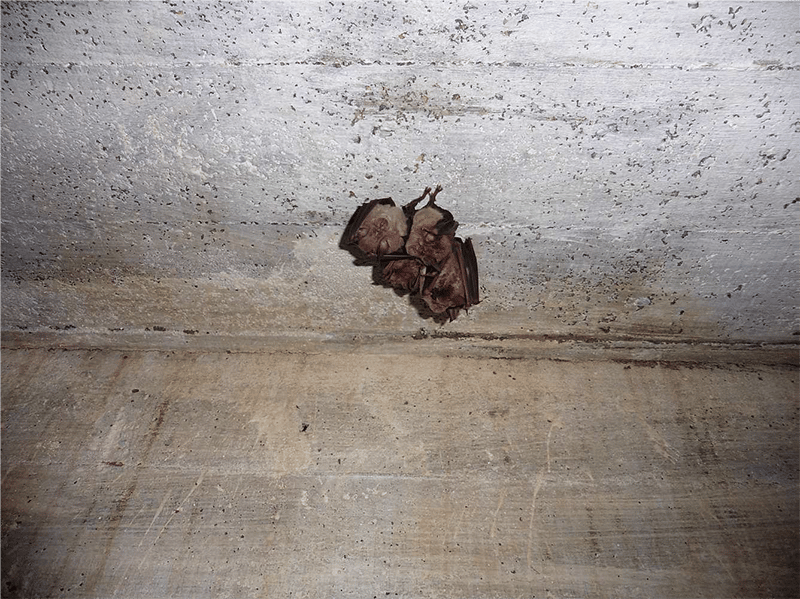
On this weekend of the European Heritage Days 2022, the theme of "Sustainable Heritage and the challenges facing the sector in terms of climate change and the accelerated degradation of the environment, we wanted to share with you an initiative by the Loctudy town council to maintain biodiversity in the cannery as part of the museum project.
This is a little known fact in the history of the Loctudy cannery. Before the restoration of the factory in autumn 2019, the building housed a colony of about fifteen bats (Great Rhinolophus). The latter had taken up residence in the cellar of the factory which they accessed through a hole in the roof of the factory, which was badly damaged at the time.
During the first phase of consultation of companies, in the framework of the public calls for tender relating to the restoration project of the building, the former finance representative in charge of the project, Jean Laouénan, had discovered the presence of bats in the cellar of the factory. He then asked Jean-Jacques Chever, an active member of the Loctudy ornithology association and Christian Lioto of the Finistère section of the Mammological group of Brittany (CMB) to discuss the future of the colony within the cannery as part of the museum project.
Protected in France since 1981, the Great Rhinolophus is listed in the European Fauna and Flora DirectiveThis is why the municipal team decided to take into account the presence of this colony in the layout of the future museum. This is why the municipal team decided to take into account the presence of this colony in the layout of the future museum, thus combining the preservation of the built heritage with the protection of the natural heritage. This integration of the habitat issues of the bat colony into the restoration work on the factory was manifested in several ways.
From the point of view of scenographicIt was decided that the cellar would not be included in the area made accessible to the public as part of the visit, in order to preserve the tranquillity of the colony. On the other hand, a reflection on how to make the presence of this colony known to the general public was set up. The team worked on setting up a video equipment in the cellar with a live broadcasting system visible in the museum space, so that visitors can observe the daily life of the colony from a safe distance.
From a technical point of view, a major problem had to be resolved. Before the work was carried out, the bats accessed the factory cellar through a hole in the roof. As part of the roof restoration, a new access for the colony to its habitat had to be considered. The window in the lower part of the eastern façade of the building, which opens directly onto the cellar, was therefore unblocked to provide a new external access.
From a proactive point of view, the municipal team has taken into account the advice of Christian Lioto of the Finistère section of the Groupement mammologique de Bretagne (CMB) to install a nursery (or breeding site) under the roof of the 4e The work involved treating the existing openings to prevent predators from entering the building. The work envisaged concerned the treatment of existing openings to prevent the penetration of predators. The window of the 4e The east side of the factory was fitted with a suitable opening.
In the interest of preventionThe municipal team, in consultation with the companies working on the site, also ensured that the materials used to restore the roof and framework of the factory's attic did not contain no harmful treatment products. The installation of nesting boxes for swallows, as well as wooden cottages and plaster bricks to facilitate the establishment of other species of chiropterans, was envisaged in consultation with the Loctudy ornithology association.
Sources: report by Christian Lioto of the Finistère GMB following his visit to the cannery in 2019 and article in the Telegram written a few months later.

On the occasion of the european heritage days 2022The museum welcomes you free of charge on weekend of 17-18 Septemberfrom 9am to 12.30pm and from 2pm to 6pm. Free activities are planned within the establishment on these two days. Some of them can be booked by phone at 02.98.98.83.99. You can also consult the programme of Loctudy on this particular weekend via the pdf below.
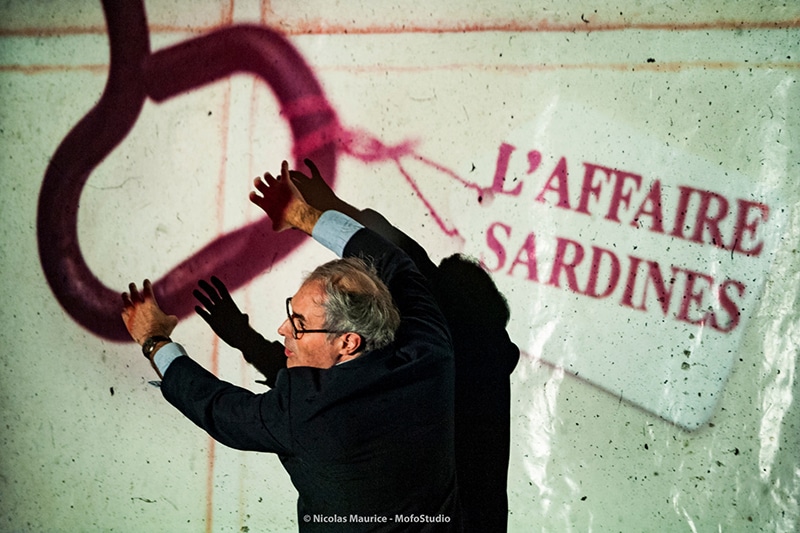
On 10 August, as part of the summer entertainment programme "Les Mercredis, c'est Loctudy!", the town will have the pleasure of welcoming the famous professional entertainer Erik Sanka. The latter will come to perform his play "L'Affaire Sardines" which earned him the distinction of Street Arts Icon by the magazine Télérama. The performance will take place at the bottom of the rue du port from 10pm to 11pm. This is how he presents his play on his website website :
"What if "Les Sardines" was a town full of history and Cook a Corsican gendarmerie captain? The protagonist of the case advocates a more scientific justice. Using sardine tins and slides, he reconstructs the world in just 42 minutes. Russian submarines, princesses who are not from Monaco, evidence by nine where we split hairs... This final conference says it all so that everything is said and so that you have nothing more to say.

The Sardine Affair
A play by Erick Sanka
Avec-ou-Sanka Company
Wednesday 10 August 2022
From 22:00 to 23:00
At the bottom of the rue du Port in Loctudy
Free access
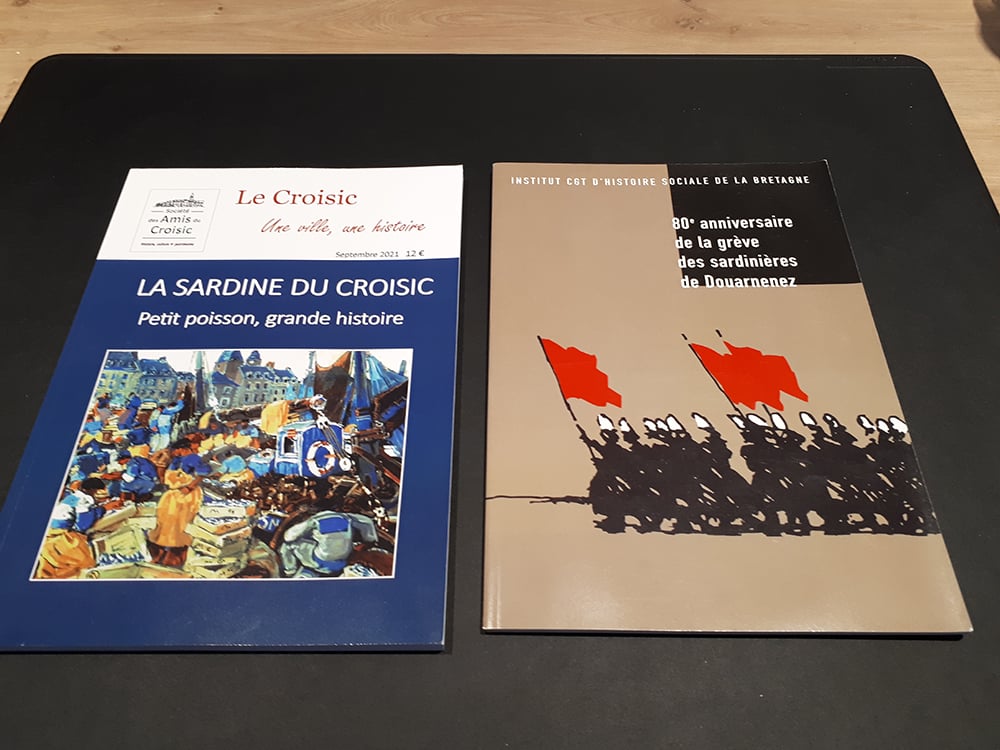
The magazine "La sardine du Croisic. Petit poisson, grande histoire", as well as the magazine published in 2004 by the Institut CGT d'histoire sociale de la Bretagne on the occasion of the 80th anniversary of the strike of the Douarnenez sardine workers, were given to us by a kind Mrs Béatrice Verney, president of the Société des Amis du Croisic. This magazine was published last September, at the same time as the Musée de la conserverie de Loctudy officially opened its doors to the general public. An exhibition on the theme of the magazine opens today at the Maison du Patrimoine in Le Croisic and will be open to the public free of charge on Wednesdays and Sundays from 4 to 6.30pm until 4 September 2022.
The magazine on the 80th anniversary of the Douarnenez sardine workers' strike was offered to the association of the Friends of the Loctudy cannery by Robert Salaun, departmental president of the CGT Institute of Local History of Brittany, and Gaston Balliot, a Loctudist passionate about social history. This review was published in the context of the symposium devoted in November 2004 to the 80th anniversary of the victorious struggle of the Douarnenez sardine workers.
Many thanks to our generous donors. Their donations will be used to enrich the museum's archival collection.

During the summer months of July and August, we will have the pleasure of welcoming the artist Eddy Dumont to the museum. Originally from Normandy, this photography and intaglio print enthusiast moved to Loctudy three years ago with the intention of opening his own intaglio printmaking workshop. He discovered rotogravure in 2014 with Phillipe Martin, who was teaching printing techniques at the Rouen School of Fine Arts. The artist was very quickly seduced by the complexity of this ancient photographic reproduction technique, which allows him to apprehend his shots differently, both in terms of nuances and textures. His search for new exploitable materials led him to try intaglio engraving. Simple, fast and accessible to all, it is this technique that the artist proposes to make discover to the families, this summer, in the enclosure of the Museum of the Cannery around a workshop of initiation to the engraving on lid of sardine cans.
To discover Eddy's work, go to his account Facebook @EddyDumontHélioFecltrois or on its account Instagram @atelier.obraz
Introduction to sardine can engraving workshop by Eddy Dumont
Target group: families (mixed adults & children from 6 years old)
Duration: 2 hours
Number of places limited to 8 participants
Price: 3€/child and 13€/adult
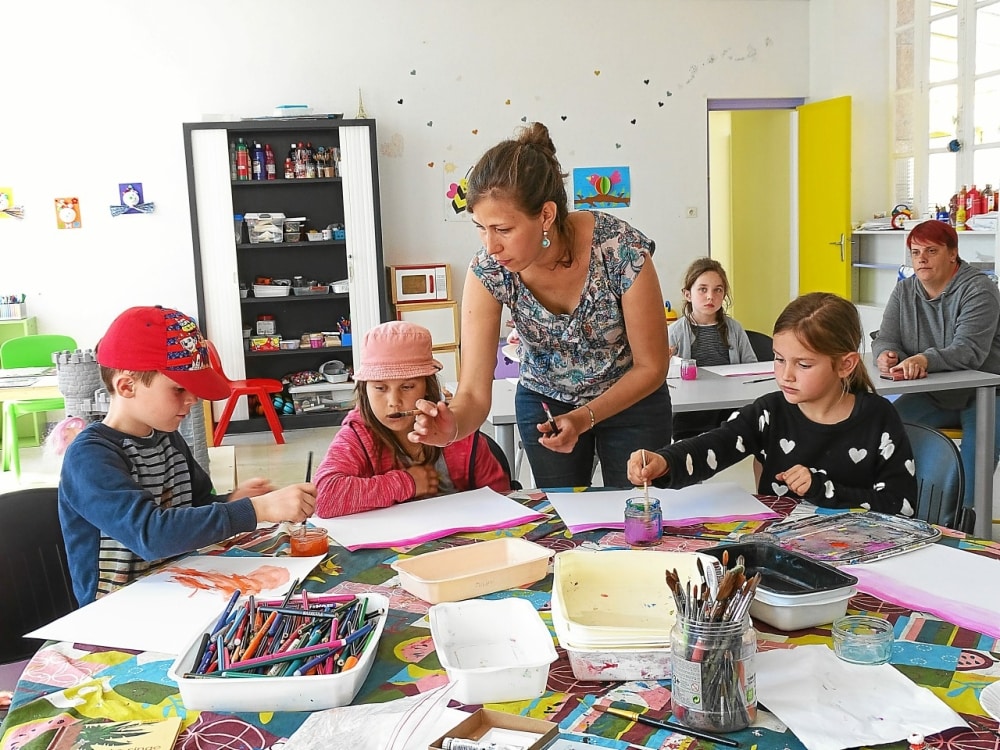
During the summer months of July and August, we will have the pleasure of welcoming the illustrator Chloé Fraser to the museum. A graduate of the École supérieure des arts décoratifs de Strasbourg, the artist, who lives in Pont-l'Abbé, published her first children's book in 2015. In 2021, together with former art teacher Solenne Roy, she created the association "La Balade illustrée", which offers artistic workshops on painting, engraving, illustrations with different techniques and monotype for children from 4 years old, teenagers and adults. The association also offers art courses during the holidays, as well as outdoor sketching trips. It is on her favourite theme, the "illustrated walk", that the artist will be working this summer with the museum to help children create a little travel diary around their visit to the Loctudy cannery.
To discover Chloé Fraser's work, please visit Facebook @LABaladeillustreethe page Instagram @labaladeillustree or the website: https://www.labalade.org/labo
Workshop to create a travel diary illustrated by Chloé Fraser
Target group: children aged 6 to 11
Duration: 2 hours
Number of places limited to 8 children (without accompanying parent)
Price: 3€/child
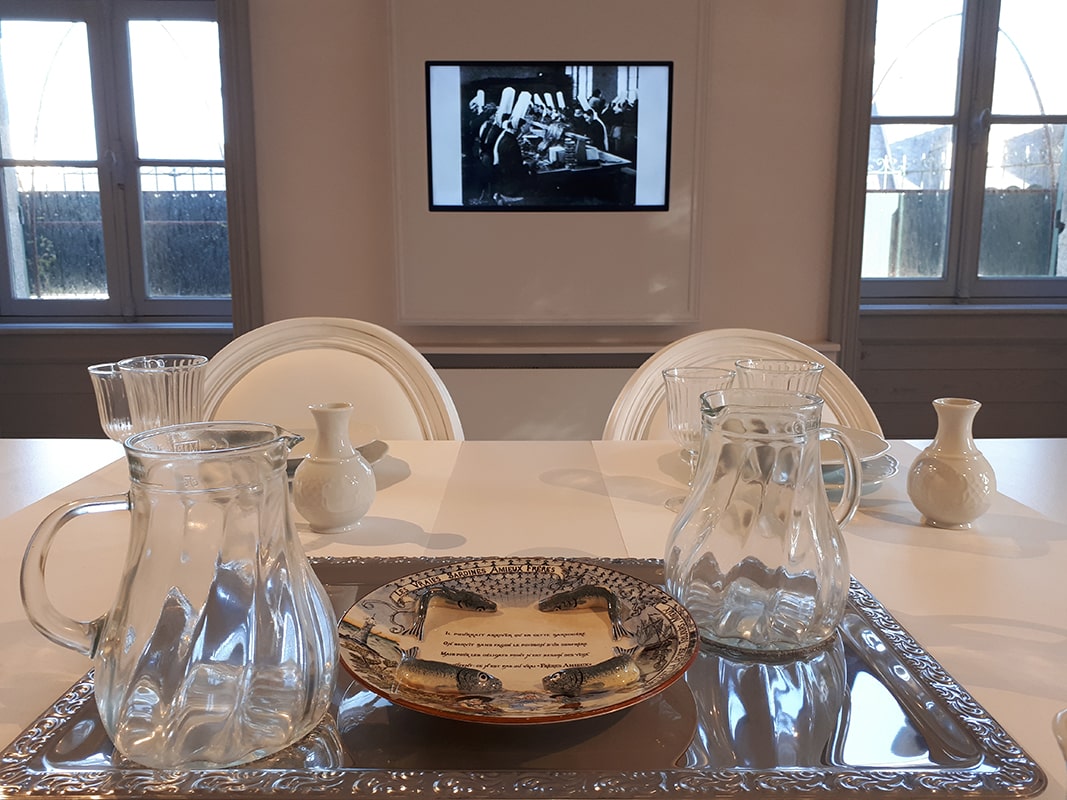
This ceramic plate was made in the artistic earthenware workshop of Georges Dreyfus in Moret-sur-Loing (Seine-et-Marne department, Île-de-France region), which operated from 1890 to 1936.
Georges Dreyfus was a professional in tableware and ceramic arts. From his workshop came a varied production, carefully decorated by a wide variety of artists whom the art dealer called upon for artistic collaborations.
Many pieces from the workshop were intended for table service, such as dishes, plates and tureens that Georges Dreyfus sold in his Parisian shop on rue du Paradis.
Commissioned by the Amieux brothers, two famous canners from Nantes known for their pioneering and ingenious advertising strategies, this polychromatic earthenware plate was made using the barbotine technique.
The slip decoration consists in adding relief on a pottery. Here this relief takes the form of four elegant sardines which frame the emblematic poem of the Amieux Frères company.
The marli, i.e. the peripheral part of the plate constituting the slightly inclined crown, is here carefully decorated with Breton landscapes (lighthouse, boat, biniou player, couple of dancing Bretons) as well as the slogans of the Amieux Frères company written in phylactery, i.e. in the spirit of medieval calligraphy.
The copy we now have was donated by Pierre Quillivic, former technical director of the Paul Chacun cannery and technical and production manager of the Cobreco (Arok) cannery, and current municipal councillor in charge of issues relating to the Loctudy cannery museum. We thank him warmly for this donation.
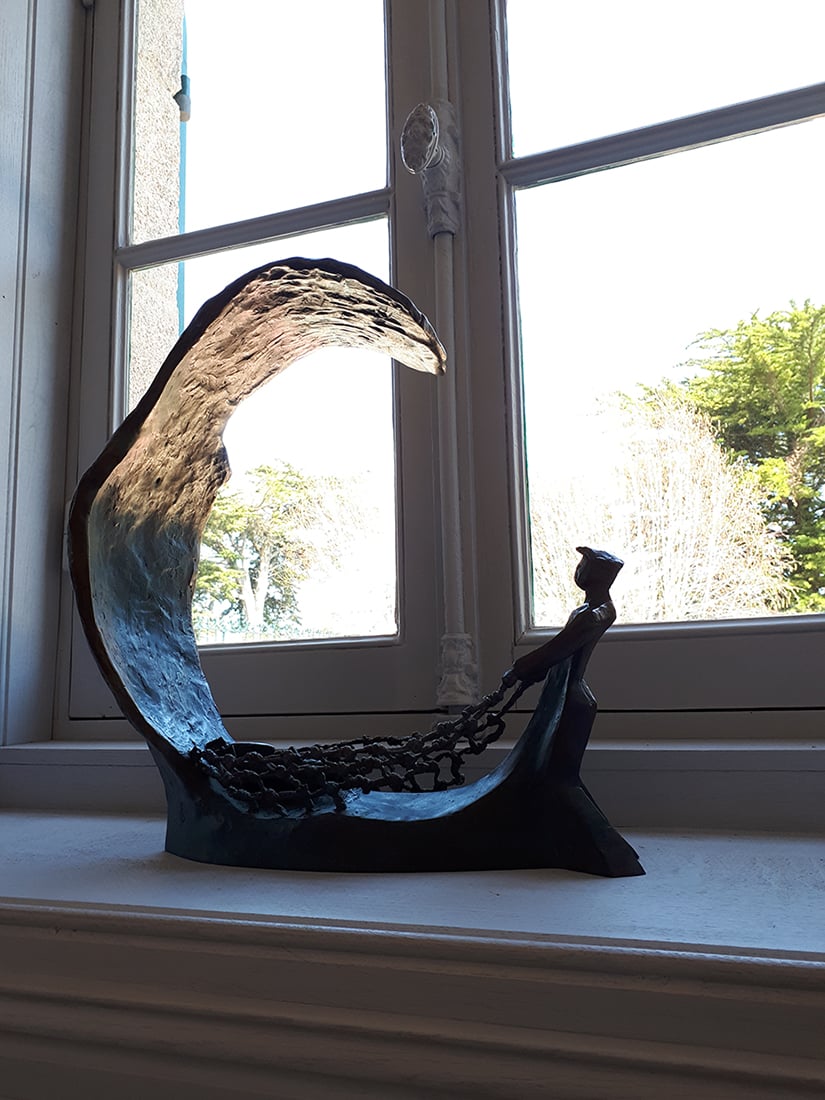
On the windowsill of the dining room, you will have the opportunity to admire the sculpture Oceano nox of the self-taught artist Jean-Pierre Gendra. Since his first encounter with the material in 1989 through clay modelling, the artist has tried his hand at several of them. In particular, he tested direct carving on wood before falling in love with bronze, which he successfully cast for the first time in 1993. He describes this experience as follows: "Bronze is living a journey with creation, leading to all the stages of the work, from conception to technical realisation, especially the fascinating moment of the fusion of the metal".
For his sculpture Oceano nox created in July 2013, the artist wanted to convey the harshness and danger of the fisherman's job. With this work, he also aims to make the public think about ecological issues such as the dangers of overfishing and the importance of having a reasoned approach in the use that Man makes of natural resources.
To discover the artist's other works, visit her website at click here.